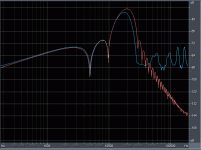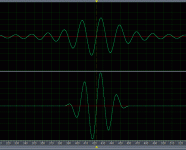^Do you mean this? Beat (acoustics) - Wikipedia
Yes and in the data shown? I know how it gets there but is this happening with the waveforms being processed/heard on CD when music is playing?
THx-RNMarsh
It's just a consequence of the beat frequency, the cos(2.5k) modulation.. I wouldn't worry about it. I pointed it out as it was a waveform inconsistencyWhat's this 180 degree phase changes all about. Flipping back and forth with polarity reversal cant be something to improve the sound quality.
-RNM
I only worry about the possibility envelope modulation introduces spectra that are filtered out when the spectra exceeds the filter break.
jn
FWIW I run my miniDSP at 24/96. Cos I can...
😱
I bough one and was going to use it until I saw all the I/O opamps were 741's.
OMG. No HF filter on input, either. Good features but that killed it for me. It would be the sonic bottle-neck in my system.
THx-RNMarsh
Last edited:
It's just a consequence of the beat frequency, the cos(2.5k) modulation.. I wouldn't worry about it. I pointed it out as it was a waveform inconsistency
I only worry about the possibility envelope modulation introduces spectra that are filtered out when the spectra exceeds the filter break.
jn
OK
-RM
As Jn says, don't worry about it. It's an inherent part of music, happens all the time in the linear world of acoustics. It's not as scary as it looks as frequencies aren't changed, it just looks that way and the reversal is part of why.Yes and in the data shown? I know how it gets there but is this happening with the waveforms being processed/heard on CD when music is playing?
Last edited:
Looks the same to me, the log scale makes it harder to judge. The 5x20 input is exactly the same, the filtered output (written at 384) is fine, too, but shows additional stop-band hash from the stepped output (no idea why this happened, are you on LTspice IV or the newer version, might have to do with that?)Fully separated from the ongoing discussion that doesn't have my attention, I have the impression that we did not do precisely the same.
Shown below is the FR and GD of the Fir filter that I used and as mentioned before 'not exactly a brick wall filter', but the best I could get in LTSpice with a constant GD for a "quick and dirty test".
But what a difference from your FR ?
The basic observation still stands.
Attachments
😱
I bough one and was going to use it until I saw all the I/O opamps were 741's.
OMG. No HF filter on input, either. Good features but that killed it for me. It would be the sonic bottle-neck in my system.
THx-RNMarsh
They are not 741s. It measures well and I2S is available on a header to add my own DACs down the line. I'm feeding SPDIF in so the HF filter is not an issue. You saying your PA amps are better?
That is neither a valid nor correct conclusion from the difference seen, why do you insist to be that stubborn?The carrier is shifted in frequency away from the initial one.
I compared the zero crossings of the 5x20 and a perfectly brickwalled @20kHz copy of it, and yes, the zero crossings do spread out as they must but the relation 1/(zero-crossing-gap)==original carrier freq -- which never changed -- simple does not hold after brickwalling or any other EQ, that is the point where you are going wrong here.
...No one as far as I can tell has said that you shouldn't record at the highest bit depth and speed that you can in the studio. There are good reasons for this. The point is that redbook rates are more than adequate for domestic replay and there is nothing more than conjecture over if this statement can be disproved. I don't think also that anyone has said that well heeled pensioners should not pay over the odds for hi-rez downloads from scraggy old master tapes if they want to. It's their trying to force it down our throats that we don't like.
I think it bears restating at this point that the consumer delivery format is just a "box." The size of this box (cassette, vinyl, CD, high-res) has ramifications in the production process:
As has been stated to death, many or most "hi-res" re-releases are no better than the 16/44.1 originals. Many or most are (other than perhaps a slight noise floor improvement due to unlimiting) identical to their 16/44.1 releases.
The only reason I purchase hi-res re-releases is when the new master has been created by re-authoring the title from the original recordings which brings with it a chance for great improvement. With knowledge that the output format is 24/xx, the newly created master can dispense with much limiting, bandpassing and other sins required to optimize the recording for an inferior consumer delivery format. Edit: In this respect the improvement has little to do with the delivery format being "hi-res."
Regarding new releases, I will vouch from much professional experience that, when properly level-set with shaped dither, there can be vanishingly little difference between a 16/44.1 release and a 24/xx release. For some orchestral and other dynamically challenging material, the mastering engineer is the one who decides how much dynamic range to leave in the recording. If they were to not limit it, it would argue to use 24/xx as the output format. This of course would place severe demands on the playback system. This may or may not influence the record label to employ limiting. I know we worked with Telarc (RIP Jack Renner) to optimize placement of the recordings within the dynamic range of the CD release consumer format with this in mind. We performed similar experiment and iterations with Sheffield, DMP and others to optimize the CD release formatting.
In all of these cases, the final result depends on the skill of the mixing and mastering engineer and the desired target output format. There are some great sounding CDs the existence of which proves that for many types of music 16/44.1 is not a limiting factor in delivered fidelity. However, the lower the capability of the delivery format, the greater skill required to deliver the music with minimal compromise. 25 years ago I could have played you a Sheffield Dolby S cassette replicated at high-speed which was the equal or better of the CD (when played back on a Nak 1000 with external S decoder)...but having stated that I'm sure I have destroyed my reputation here, so I'll end this missive.
Cheers!
Howie
p.s. the current Sheffield hi-res releases are taken from vinyl transfers...
Last edited:
yup.and yes, the zero crossings do spread out as they must
So, you are saying that two completely different waveforms are identical?..with a straight face...
In actual fact, the waveforms are absolutely consistent, but the output has been time spread. If you expand the input waveform in time, it actually duplicates the output waveform. (of course include height change).
So both envelope and carrier have been time spread.
jn
ps. It's not being stubborn. It's not accepting explanations which do not explain what is clearly evident.
Come up with a good explanation as to why two waveforms, one spread in time, are identical.
Last edited:
Howie: Question for you. Back in the bad old days of CD being new there was a pre-emphasis feature. Did anyone actually use that in releases. I know that, bar KOJ few people adopted HDCD.
...
I compared the zero crossings of the 5x20 and a perfectly brickwalled @20kHz copy of it, and yes, the zero crossings do spread out as they must but the relation 1/(zero-crossing-gap)==original carrier freq -- which never changed...
... the waveforms are absolutely consistent, but the output has been time spread. If you expand the input waveform in time, it actually duplicates the output waveform. (of course include height change).
So both envelope and carrier have been time spread.
...
KSTR,
Possibly, you may have to re-post the attachments and show the worked out math along side the attachments for JN to see how you arrive at the correct conclusion, that no frequency shift occurs.
KSTR,
Possibly, you may have to re-post the attachments and show the worked out math along side the attachments for JN to see how you arrive at the correct conclusion, that no frequency shift occurs.
Better yet, put both waveforms together, one over the other. Show everybody that they are identical.
jn
😱
I bough one and was going to use it until I saw all the I/O opamps were 741's.
Not true. NJM2068 far cry from it. They're dual op-amps BTW did you even look?
Last edited:
Envelope yes (from heavy "Gibbs'ing" due to the steep filters), carrier no.In actual fact, the waveforms are absolutely consistent, but the output has been time spread. If you expand the input waveform in time, it actually duplicates the output waveform. (of course include height change).
So both envelope and carrier have been time spread.
Top trace: brickwall filtered output (384-->44.1-->384 resampling)
Bottom trace: 5x20 input
Attachments
Envelope yes (from heavy "Gibbs'ing" due to the steep filters), carrier no.
Top trace: brickwall filtered output (384-->44.1-->384 resampling)
Bottom trace: 5x20 input
Why are you not overlaying input signal and output signal?
jn
Not true. NJM2068 far cry from it.
yes, 2068. Thats it! Thats the one. Bad choice of opamp.
Replaced it though. Trying 4562 and others.
-RNM
Last edited:
Howie: Question for you. Back in the bad old days of CD being new there was a pre-emphasis feature. Did anyone actually use that in releases. I know that, bar KOJ few people adopted HDCD.
Uh oh, you are opening a can of worms...the CD Audio format has had many quirks, including the existence of multiple locations for a PRE flag, in both TOC and individual streaming subcodes. Some discs omitted the TOC PRE flag and had only track PRE flags, and many player firmwares ignored track subcodes of all types. They read TOC and just blindly streamed from that point other than updating the track time indication.
Also, early CD mastering systems and CD writers had a lot of quirks, including a notable one with the Sony CD authoring software where even though pre-emphasis was used, the flag was not set.
For this and many reasons I did an exhaustive test of authoring software adherence to CD Red Book (I still have a copy) using exotic testing equipment. This resulted in our standardizing on GEAR Software for CD-Audio mastering in house. The GEAR software coupled with a Plextor CD writer (long gone) on US made Taiyo Yuden archival media resulted in the most Red Book compliant CD-Audio discs with the least playability issues.
And don't get me started with CD-TEXT!!!
Cheers!
Howie
- Status
- Not open for further replies.
- Home
- Member Areas
- The Lounge
- John Curl's Blowtorch preamplifier part III


